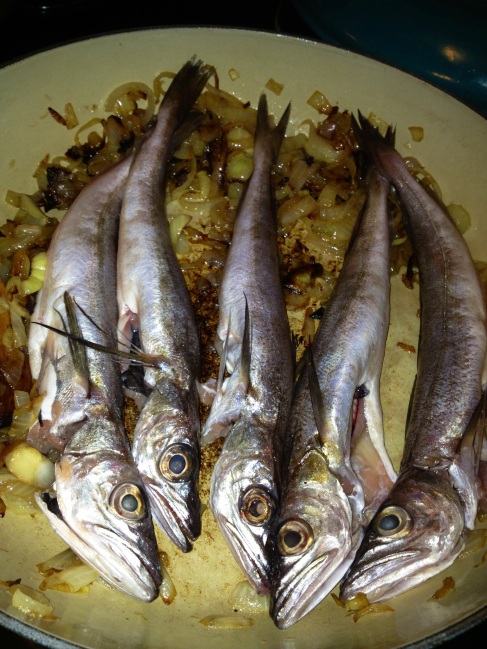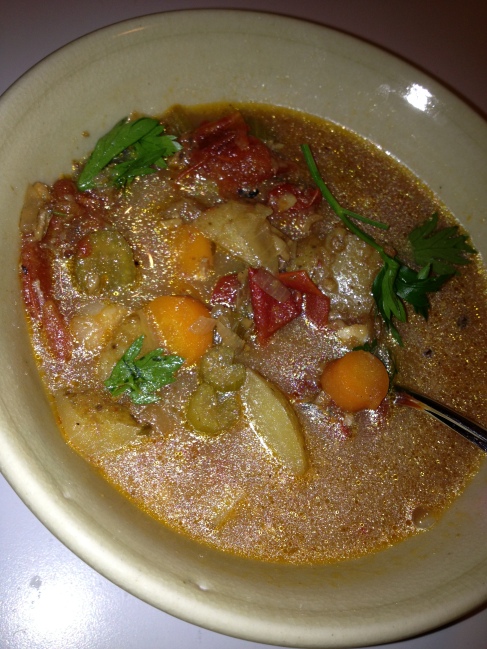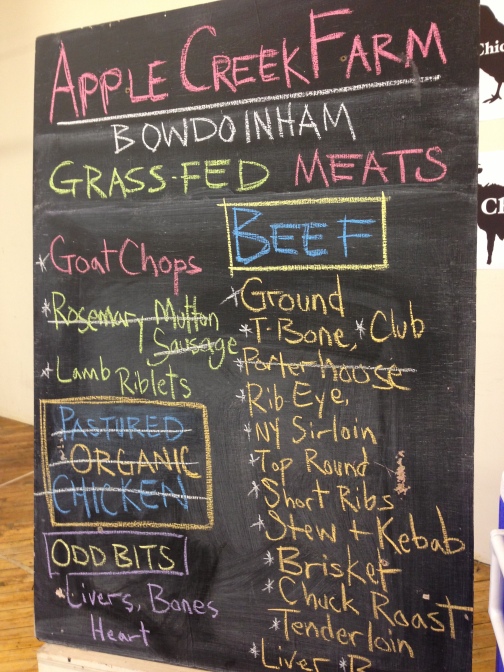Posts Tagged ‘Brunswick’
Whole Fish Stock (with Whiting a.k.a Silver Hake a.k.a Lake Trout, Heads and All!)
It’s my second September living year-round in Maine, and the access to fresh, affordable seafood is one of the things I’m most grateful for after more than a year here. Of course the produce is incredibly bountiful now, though a chill is setting in. I can barely keep up with our C.S.A. and my neglected community garden plot’s bounty. I’m actually a member of three C.S.A.s at the moment–incredibly indulgent I know, though I believe they are saving us money on food costs if you pencil everything out. In addition to the vegetable C.S.A., I just started John Bunker’s incredible bi-weekly “Out on a Limb” heritage apple C.S.A. program. And on and off for almost a year now I’ve had the privilege of being one of the inaugural members of the Salt & Sea Community-Supported Fishery, which does a weekly drop of fresh-from-the-boat fish and shellfish in Brunswick. I’ve had a chance to cook with some of the freshest fillets of pollock, Acadian redfish (my new favorite…especially pan-fried for fish tacos), haddock, dabs and monkfish you can imagine. Every week, owner Justine Simon emails us a suggested recipe for that week’s fish, which can usually be assembled with ingredients you have on hand. It takes all the guesswork out of coming up with dinner and then procuring those items. Effortless, delicious fish dinner!
Unfortunately, Justine says last week’s share caught many members off-guard. I was delighted to get her announcement of whole fish for the first time: “some lovely little whiting (silver hake) tonight from Jerry and crew on the Teresa Mare IV. They caught them close to shore as they were coming in from their trip,” Justine wrote. It’s also GMRI’s fish of the month in their excellent Out of the Blue Campaign.
I’ve had a fascination with whiting ever since living in Baltimore, where filets of the cheap fish are fried and known as the local delicacy, Lake Trout (not from a lake nor a trout). As Justine went on, “Whiting is considered a delicacy in many different types of cuisine, and is more often than not prepared whole.” I’m not sure if you can call young whiting “scrod,” but seems to be similar to young cod, haddock and other whitefish.
The whole fish thankfully came gutted and cleaned. Justine said folks most often remove the head, fins and tail, then dredge the fish in egg and flour and either fry or bake them. But my in-laws had just arrived, so we opted for take-out (something we rarely do) to avoid the mess of frying fish.
So I gladly opted for Justine’s latter suggestion that whiting are perfect for fish stock for those who “don’t want to wrestle with small fish.” I’d never made fish stock before, but this was the perfect alternative, since we weren’t eating the fish right away. Plus, I’ve always been disappointed by the canned version. Doesn’t seem worth paying for doctored water when you have time to make your own. Justine goes on: “I was talking to an Italian woman while the boats were unloading and she gave me a simple recipe that we made last night, and it was delicious:
Fry some onion and garlic in olive oil, cook on low heat until onions are caramelized. Add plenty of water, some salt and the fish. Bring to a boil and let simmer for an hour or so. Strain, so all you are left with is clear stock. Put back in pot, and add more water, finely diced potato and carrot, orzo, parsley, salt and pepper. Yum!”
We simmered potatoes, carrots, celery, fennel, onions and tomatoes from our CSA and/or my garden in the stock, which made for a delicious meal. I just used a mesh ladle strainer to remove the fish bodies, picking off the sweet delicate meat that gave right away from the bone. It would also be perfect for bouillabaisse, cioppino or my grandmother’s Manhattan-style clam chowder.

Bagels from Union Bagel in Portland. Pale perhaps, but still chewy and delicious. At least far better than the insipid, roll-like, Mr. Bagel or Einstein’s alternative.
Surprisingly, Justine reported “overall the whiting didn’t get great reviews from the CSF.” How I often forget my tastes are more exotic and adventurous than my average fellow American. Fortunately, several members rallied to tell Salt & Sea they liked it! So they’ll at least offer it again as a preference that people of which people can opt out. Count me in! I’m ready to continue to get my hands dirty with fresh fish. If only I could have smoked these small fish as a stand-in for whole smoked whitefish at our lovely Yom Kippur break-fast we had with friends this year. I brought the bagels, local Maine lox and cream cheese instead.
Kidneys Aren’t So Offal After All

Goat and lamb kidneys (I think the smaller grey one is lamb) from Apple Creek Farm in Bowdoinham. Surprisingly delicious if first soaked in salt water and then alcohol, to remove much of that urine-y essence.
The taste-buds of toddlers, even the most omnivorous of ones, seem to grow pickier near the age of two. That’s certainly been the case with Theo. We depend upon green smoothies, fortified with kale and carrots, to get vegetables into him now. He tends to favor plain starches, bananas and peanut butter, granola and other sweet items these days. So we were delighted to discover he had a taste for lamb kidneys and liver, and tripe soup, at a recent special Greek diner menu at our beloved Trattoria Athena here in Brunswick. I was also happy to discover I had a taste for kidneys, after my unpleasant experience with rabbit ones a while back. And pleased to discover Apple Creek Farm in Bowdoinham sold delicate lamb and goat kidneys at my Brunswick farmers’ market for an affordable $3 a pound. Apple Creek farmers Jake and Abby said the only other customers who ask for them are mothers inspired by Sally Fallon’s Nourishing Traditions.
I’ve bought lamb and goat kidneys twice from them now and found them delicious. I think the goat ones had a more off-putting barnyard aroma, but by eating time, I got confused which was which. To remove the kidneys’ urine flavor (hey, urine is sterile anyway:)), I soaked them in heavily salted water and then some beer the first time and sweet vermouth the second time I made them. For a recipe, I adapted Mark Bittman’s one for breaded veal kidneys sauteed with shallots and sherry, from his How to Cook Everything. I drained the kidneys and discarded their liquid, removed tough white membranes, sliced them into tender medallions, salted and peppered them, then dredged in flour and pan-fried in butter. I kept them warm in a 200 degree oven while I sauteed shallots with more butter in the pan, and then deglazed it with sherry and sweet vermouth and a touch a maple syrup for sweetness. That sauce goes over the kidneys. Serve warm with crusty bread.
Unfortunately, now-finicky Theo refused the kidneys both times at home. Mama sure enjoyed them as an appetizer, but their richness, like liver but with a sweeter, less metallic flavor, meant I couldn’t make a meal of them. A little goes a long way with offal. Let’s hope this kid becomes omnivorous again when he turns two in June. What happened to my keen sardine eater?
Salad Perfection: Roasted Celeriac and Roasted Exotic Mushrooms with Shaved Radish (or Turnip) and Buttermilk Dressing

My recreation of a Fore Street salad, with shaved local watermelon radish instead of white turnip, and roasted celeriac and roasted meaty King Trumpets and some enoki-or-shimeji-type smaller mushroom. Delish!
I don’t usually run photos this large, but this is an unassuming salad with big flavor. It’s inspired by a truly memorable one I just had at Fore Street, perhaps this Portland’s hottest restaurant. Chef/owner Sam Hayward is Maine’s answer to Alice Waters. My parents took us to his Street& Company on a visit to Maine years ago, but I’d yet to eat at his flagship spot, just above his renown Standard Baking Co., which bakes the chewy fougasse I devoured with my appetizers at Fore Street.
Now, Fore Street is famous for its protein, its house-cured-and-smoked charcuterie, fresh Maine seafood and spit-roasted meats. So this simple salad especially stood out. The menu described a turnip and exotic mushroom salad with roasted celeriac and a light buttermilk dressing. Mushrooms on a salad usually stand out as a rare ingredient. I assumed the mushrooms would be pickled or marinated and shaved. But Fore Street is known for its wood-fired cooking. It turns out the mushrooms were quickly roasted, to seal in their juices and concentrate their flavor. How had I, long a slave to mushrooms in the sautee pan, never thought of roasting them before? So I sliced up some locally-cultivated King Trumpets and shimejis (smaller clumped ones like big enokis), rubbed them with olive oil, Maine sea salt and pepper, and into the 450 degree oven they went, along with the cubed celeriac. The buttermilk dressing, with Kate’s legit buttermilk from Maine’s Old Orchard Beach, came from a Vermont locavore cookbook. Recipe to come.
It wasn’t hard coming up with my “Meals We Loved” pick for today’s radio show (our second) I taped with fellow Brunswick food writer, Michael S. Sanders. The topic was sustainable seafood. Visit the Table Arts Media page for a soon-to-be-posted podcast of the show. We have a lot of kinks and technical glitches to iron out, but hey, it’s college radio. And as Michael reminded me, James Beard Award-winning chef Sam Hayward’s first restaurant experiment in Maine–22 Lincoln right here in Brunswick–actually went under after a 10-year-run. But, to the delight of diners everywhere, that sure didn’t stop him.
Short Ribs Once, Dinner Thrice

The surprise of short rib ravioli with tangy horseradish-creme fraiche sauce, dusted with parmesan and fresh cracked pepper. More Slavic than Italian. Absolutely divine. Hats off to chef Amy.
It wasn’t hard coming up with the “food I loved” for the new “Fresh from Maine” radio show I launched today with veteran Brunswick food writer and cookbook author Michael S. Sanders. It was a simple, Silver Palate-inspired winter borscht, a velvety broth with beets, tomato and braised cabbage, held together with a meaty short rib broth. Michael served it for lunch as we pulled together the show last week. Hands down best borscht I’ve ever had.
It turns out Michael’s discovery of these short ribs discounted at Shaw’s (the large grocery store with the best meat selection) led to not one, but three distinct meals. Talk about frugal gourmet. First, they slow-braised the short ribs in beer, plating the fall-off-the-bone morsels atop polenta. The recipe came from Michael’s lovely Fresh from Maine cookbook, he thought from the Portland restaurant, Vignola Cinque Terre. Or was it the “Stout and Chili Braised Short Ribs over Parmesan Polenta” recipe from the Harraseeket Inn in Freeport? The only expensive thing was the gluten-free beer required for braising to accommodate a guest’s dietary preferences. Meal #1.
The braising liquid and bones Michael and his wife, Amy, then boiled down into stock with the requisite veggies. The resulting rich elixir yielded the most delicious borscht. No tough chunks of meat here but more umami-rich and savory than the still-good, vegetarian Moosewood version. Meal #2.
And Meal #3 was today to celebrate our first radio show (for now on Sundays at noon…live-stream it!) on WBOR, the Bowdoin College station. Michael and Amy graciously invited us to join them and their neighbors for an impromptu, quite convivial meal embodying the best of the Slow Food ethos. Amy, who is busy as an AP English and creative writing teacher at the high school, still managed to whip up a batch of homemade ravioli, putting the leftover short rib meat to good use. But don’t let the “ravioli” label fool you. These were more Slavic, almost like pirogis or Russian pelmeni, than Italian pasta. No coincidence here, since Michael and Amy speak Russian, and he used to import rugs from there and the Ukraine. A light horseradish-creme fraiche sauce perfectly complemented the sweet short rib meat. The ravioli reminded me of my Nonny’s kreplach, which I have yet to recreate. Here’s to more short ribs and homemade ravioli (and kreplach) in 2013!
Fresh Monkfish: Salt & Sea C.S.F. Share #1

The just-caught fresh monkfish tails from Salt & Sea Community-Supported Fishery, with a spice packet of cinnamon sticks and whole cloves to simmer on the stove separately as the fish cooks, to eliminate any lingering fishy odors.
I love Community-Supported Agriculture (CSAs), though I was hardly an early adopter. I used to think they’d be too confining and limit the spontaneity of buying what one stumbled upon at the market. But CSAs are economical and efficient. They’re all about the paradox of choice. Having a fixed set of ingredients to work with makes dinner preparation faster and in many ways, more enjoyable. You’re allowed infinite freedom and creativity under these restraints. You also spend less time wandering aimlessly around the market.
We did our first CSA, a winter share, last year through the Willamette Valley’s Open Oak Farm. We learned that eating truly local through the winter means embracing more bitter greens, such as escarole. Last spring, we also dabbled in a start-up cured and fresh meat CSA. Now we’re doing a wonderful fall CSA with Small Wonder Organics here. But we’ve never before had the opportunity to become a member of a Community-Support Fishery. Until now.

I salted the fresh monkfish fillets (which are actually the meaty tails) and let them sit an hour, then drained them and patted them dry. Jamie Oliver recommends this step to prevent the monkfish from becoming mushy by boiling in its milky juices. I also tried to remove as much of the thin gray membrane as possible, using my fingers and sharp knife.
Coastal Maine is home to Port Clyde Fresh Catch, the nation’s first community-supported fishery. But I found the start-up Salt & Sea C.S.F. even closer to home. Fish is supplied from medium-sized trawlers and small gill-netters run by the Odlins, a fourth-generation old Portland fishing family, their cousins and other local Portland fisherman. Salt & Sea’s Justine Simon, who married into the family, says the experience for members mimics how fisherman share fish with their families when they come home from trips, trading recipes and fresh filets. The goal is to create new markets for more sustainable, but often less appreciated and unknown, varieties of fish. Simon says all their species are plentiful in the Gulf of Maine. Like monkfish.
I picked up my first installment, a pound of monkfish, at the weekly drop-off site at Morning Glory Natural Foods in Brunswick. We need more members to keep this drop-off site viable, so tell your local friends! It was so fresh, with no fishy aroma. For those who are squeamish about fish (do those people, who are not vegan or vegetarians, even still exist?), Salt & Sea included a cute little packet of spices to simmer in a small pot before you start cooking your fish, to combat fishy aromas.
They also included a recipe card for “Roasted Monkfish,” to take the guesswork out of how to cook this new fish. The recipe came from Mark Bittman’s How to Cook Everything. I dredged the monkfish steaks in a mixture of flour and chopped herbs, salt and pepper and preheated the oven to 450 degrees. I seared the fish in a hot skillet, browning on all sides to develop a crust. I added broth to the pan and then transferred it to the hot oven to cook until it was tender. And tender and sweet it was. Now I just have to ask Salt & Sea how to get my hands on monkfish liver, a Japanese delicacy I once enjoyed at a cute Brooklyn sushi spot, whose name now escapes me, with my sister-in-law, Julia.






